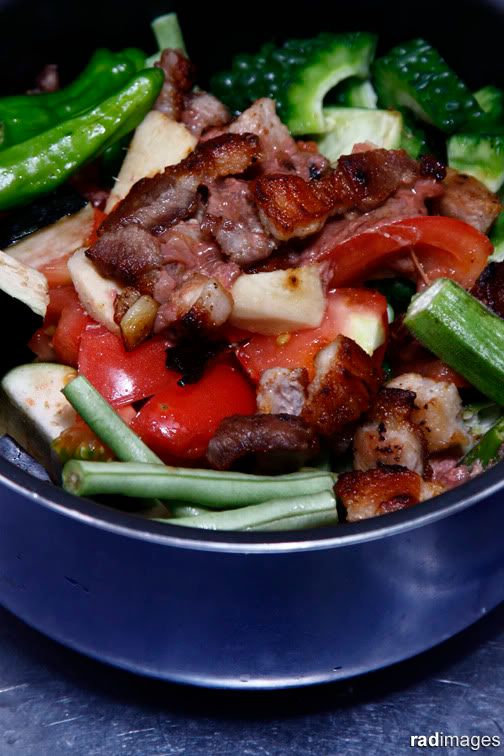
We called home today and they told us they were having frogs for lunch. A local delicacy. Since I have no way of getting hold of the same today, I decided to cook something close (not to frogs but to home, that is.). What`s more traditional Ilocano cooking than INABRAW? So timely because yesterday I spotted a lot of jute at the supermarket. If only there were malunggay but I guess I have to be thankful that at least familiar veggies were there.
Inabraw is also called
dinengdeng and it usually contains a
mixture of veggies in a bagoong (salted/fermented bonnet mouth fish or the shiokara 塩辛) soup base. It is different from pinakbet in that, inabraw is more soupy, less veggies and usually do not have tomatoes. Ilocanoes are voracious vegetable eaters and most of the combinations of vegetables in inabraw are those that can be found in one`s backyard. Perhaps this is one reason why Ilocanos are thought to be thrifty to the point of stinginess because most never have to go to the market to buy food because they can have a proper meal with just the leaves and fruits from their backyards.
Most common combination is malunggay (or leaves from the horseradish tree or Moringa oleifera) and jute or saluyot (moloheya or Corchorus sp.). I sometimes think that an Inabraw with only malunggay and jute in bagoong is the basic Inabraw. Some say one is not an Ilocano if they don`t have at least one horseradish tree in their yard. Jute on the other hand, grows just about anywhere and during rainy season, they just come out.
Cooking inabraw consists only of boiling water then adding the bagoong and then the veggies. Here are tips though that my parents especially my father taught us to make sure that the inabraw will come out appetizing and delicious. Other people may have different ways of preparing but this one works for me and my family.
1. Do not put too much water or else it will come out too soupy or what he terms as bumiraw biraw. It is not so appetizing to see all the veggies drowning in the soup base plus the excess water will dilute the taste from the veggies.
2. Put minimal bagoong. Although it is in a bagoong soup base, putting too much of bagoong will make it too salty. For a recipe for a family of 6, we usually just use about 1 tablespoon or lesser.
4. Put veggies which are hard to cook, first, and the leaves last. For example, in the above inabraw, I put the bitter gourd, then the eggplant and the jute leaves last. (by the way, the combination of the bitter gourd and jute is good because the sweetness from the jute contrasted with the bitterness of the gourd and the result is really so good!).
3. Never overcook the veggies. My father always stressed on maintaining the color of the veggies especially the green leafy ones. So, do not wait for the veggies to cook before you put in the next one. It is all about timing.
4. Boil a bit of ginger in the water before putting the bagoong. My mom taught me this. It adds flavor.
5. Add fried fish or pork or leftover pork adobo into the soup to have a little meaty taste.
6. If you do it right, you will never have the need to add msg or additional salt.
Now the only thing that I have to figure is how to cook inabraw without ever using bagoong. Rad wants it that way, but then it won`t be inabraw anymore. A bit of warning though, eating inabraw is an acquired thing. Oh well, mangantayon!































